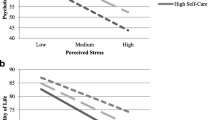Abstract
Objective
The authors studied the prevalence of health-promoting and health-risking behaviors among physicians and physicians-in-training. Given the significant potential for negative outcomes to physicians’ own health as well as the health and safety of their patients, examination of the natural history of this acculturation process about physician self-care and wellness is critical to the improvement of the western health care delivery system.
Methods
963 matriculating medical students, residents, or attending physicians completed the Empathy, Spirituality, and Wellness in Medicine (ESWIM) survey between the years 2000 and 2004. Items specific to physician wellness were analyzed. These included healthy behaviors as well as risk behaviors.
Results
Both medical students and attending physicians scored higher in overall wellness than did residents. Residents were the lowest scoring group for getting enough sleep, using seatbelts, and exercising. Medical students were more likely to smoke tobacco and drink alcohol. Medical students reported less depression and anxiety and more social contacts.
Conclusion
Medical school training may prevent students from maintaining healthy behaviors, so that by the time they are residents they exercise less sleep less and spend less time in organizational activities outside of medical school. If physicians do not engage in these healthy behaviors, they are less likely to encourage such behaviors in their patients and patients are less likely to listen to them even if they do talk about it.
Similar content being viewed by others
References
Coulehan J, Williams PC: Vanquishing virtue: the impact of medical education. Acad Med 2001; 76: 598–605
Toyry S, Rasanen K, Kujala S, et al: Self-reported health, illness, and self-care among Finnish physicians: a national survey. Archives of Family Med 2000; 9: 1079–1085
Frank E, Rothenberg R, Lewis C, et al: Correlates of physicians’ prevention-related practices. Findings from the women physicians’ health study. Archives of Family Med 2000; 9: 359–367
Frank E, Biola H, Burnett CA: Mortality rates and causes among U.S. physicians. Am J Prev Med 2000; 19: 155–159
Schernhammer ES, Colditz GA: Suicide rates among physicians: a quantitative and gender assessment (meta-analysis). Am J Psychiatry 2004; 161: 2295–2302
O’Connor PG, Spickard JA: Physician impairment by substance abuse. Med Clin North Am 1997; 81: 1037–1052
Shanafelt TD, West C, Zhao X, et al: Relationship between increased personal well-being and enhanced empathy among internal medicine residents. J Gen Intern Med 2005; 20: 559–564
DeVoe J, Fryer GE Jr, Hargraves JL, et al: Does career dissatisfaction affect the ability of family physicians to deliver high-quality patient care? (Original Research). 2002; 51: 223
Landrigan CP, Rothschild JM, Cronin JW, et al: Effect of reducing interns’ work hours on serious medical errors in intensive care units. N Engl J Med 2004; 351: 1838–1848
Lockley SW, Cronin JW, Evans EE, et al: Effect of reducing interns’ weekly work hours on sleep and attentional failures. N Engl J Med 2004; 351: 1829–1837
Ayas NT, Barger LK, Cade BE, et al: Extended work duration and the risk of self-reported percutaneous injuries in interns. JAMA 2006; 296: 1055–1062
Barger LK, Cade BE, Ayas NT, et al: Extended work shifts and the risk of motor vehicle crashes among interns. N Engl J Med 2005; 352: 125–134
DiLalla LF, Hull SK, Dorsey JK: Effect of gender, age, and relevant course work on attitudes toward empathy, patient spirituality, and physician wellness. Teach Learn Med 2004; 16: 165–170
Wechsler H, Lee JE, Kuo M, et al: College binge drinking in the 1990s: a continuing problem. Results of the Harvard School of Public Health 1999. College Alcohol Study J Am Coll Health 2000; 48: 199–210
Brummett BH, Barefoot JC, Siegler IC, et al: Characteristics of socially isolated patients with coronary artery disease who are at elevated risk for mortality. Psychosom Med 2001; 63: 267–272
Linzer M, Konrad TR, Douglas J, et al: Managed care, time pressure, and physician job satisfaction: results from the physician worklife study. J Gen Intern Med 2000; 15: 441–150
Shugerman R, Linzer M, Nelson K, et al: Pediatric generalists and subspecialists: determinants of career satisfaction. Pediatrics 2001; 108: E40
McPherson M, Smith-Lovin L, Brashears ME: Social isolation in America: changes in core discussion networks over two decades. Am Sociological Rev 2006; 71: 353–375
Wedding D: Behavior and medicine (2nd Ed.). St. Louis, MO, Mosby, 1995
National Center for Health Statistics: Health, United States, 2005, with Chartbook on Trends in the Health of Americans. Hyattsville, MD, 2005
Broquet KE, Rockey PH: Teaching residents and program directors about physician impairment. Acad Psychiatry 2004; 28: 221–225
Lewis CE, Clancy C, Leake B, et al: The counseling practices of internists. Ann Intern Med 1991; 114: 54–58
Frank E, Galuska DA, Elon LK, et al: Personal and clinical exercise-related attitudes and behaviors of freshmen U.S. medical students. Res Q Exerc Sport 2004; 75: 112–121
Frank E, Breyan J, Elon L: Physician disclosure of healthy personal behaviors improves credibility and ability to motivate. Archives of Family Med 2000; 9: 287–290
Igartua KJ: The impact of impaired supervisors on residents. Acad Psychiatry 2000; 24: 188–194
Author information
Authors and Affiliations
Corresponding author
Additional information
Funding for this study was provided in part by an award from the National Institute for Healthcare Research.
Rights and permissions
About this article
Cite this article
Hull, S.K., DiLalla, L.F. & Dorsey, J.K. Prevalence of Health-Related Behaviors Among Physicians and Medical Trainees. Acad Psychiatry 32, 31–38 (2008). https://doi.org/10.1176/appi.ap.32.1.31
Received:
Revised:
Accepted:
Published:
Issue Date:
DOI: https://doi.org/10.1176/appi.ap.32.1.31




